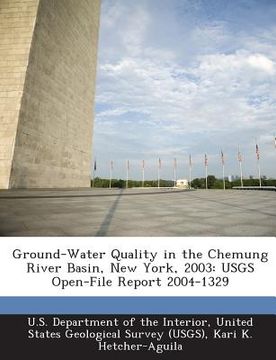Compartir
Ground-Water Quality in the Chemung River Basin, New York, 2003: Usgs Open-File Report 2004-1329 (en Inglés)
United U. S. Department of the Interior
(Autor)
·
Kari K. Hetcher-Aguila
(Autor)
·
Bibliogov
· Tapa Blanda
Ground-Water Quality in the Chemung River Basin, New York, 2003: Usgs Open-File Report 2004-1329 (en Inglés) - Hetcher-Aguila, Kari K. ; U. S. Department of the Interior, United
$ 31.850
$ 44.240
Ahorras: $ 12.390
Elige la lista en la que quieres agregar tu producto o crea una nueva lista
✓ Producto agregado correctamente a la lista de deseos.
Ir a Mis Listas
Origen: Estados Unidos
(Costos de importación incluídos en el precio)
Se enviará desde nuestra bodega entre el
Miércoles 17 de Julio y el
Miércoles 24 de Julio.
Lo recibirás en cualquier lugar de Chile entre 1 y 3 días hábiles luego del envío.
Reseña del libro "Ground-Water Quality in the Chemung River Basin, New York, 2003: Usgs Open-File Report 2004-1329 (en Inglés)"
Water samples were collected from 24 public-supply wells and 13 private residential wells during the summer of 2003 and analyzed to describe the chemical quality of ground water throughout the Chemung River basin, upgradient from Waverly, N.Y, on the Pennsylvania border. Wells were selected to represent areas of heaviest ground-water use and greatest vulnerability to contamination, and to obtain a geographical distribution across the 1,130 square-mile basin. Samples were analyzed for physical properties, inorganic constituents, nutrients, metals and radionuclides, pesticides, volatile organic compounds, and bacteria. The cations that were detected in the highest concentrations were calcium and sodium; the anions that were detected in the greatest concentrations were bicarbonate, chloride, and sulfate. The predominant nutrient was nitrate. Nitrate concentrations in samples from wells finished in sand and gravel were greater than in those from wells finished in bedrock, except for one bedrock well, which had the highest nitrate concentration of any sample in this study. The most commonly detected metals were aluminum, barium, iron, manganese, and strontium. The range of tritium concentrations (0.6 to 12.5 tritium units) indicates that the water ages ranged from less than 10 years old to more than 50 years old. All but one of the 15 pesticides detected were herbicides; those detected most frequently were atrazine, deethylatrazine, and two degradation products of metolachlor (metachlor ESA and metachlor OA), which were the pesticides detected at the highest concentrations. Not every sample collected was analyzed for pesticides, and pesticides were detected only in wells finished in sand and gravel. Volatile organic compounds were detected in 15 samples, and the concentrations were at or near the analytical detection limits. Total coliform were detected in 12 samples; fecal coliform were detected in 7 samples; and Escherichia coli was detected in 6 samples. These bacteria were detected in water from bedrock as well as sand-and-gravel aquifers. Federal and State water-quality standards were exceeded in several samples. Two samples exceeded the chloride U.S. Environmental Protection Agency Secondary Maximum Contaminant Level of 250 milligrams per liter. The U.S. Environmental Protection Agency Drinking Water Advisory for sodium (30 to 60 milligrams per liter) was exceeded in 11 samples. The upper limit of the Secondary Maximum Contaminant Level range for aluminum (200 micrograms per liter) was exceeded in one sample. The Maximum Contaminant Level for barium (2,000 micrograms per liter) was exceeded in one sample. The Secondary Maximum Contaminant Level for iron (300 micrograms per liter) was exceeded in 11 samples. The Secondary Maximum Contaminant Level for manganese (50 micrograms per liter) was exceeded in 20 samples. The proposed Maximum Contaminant Level for radon (300 picocuries per liter) was exceeded in 34 samples.

